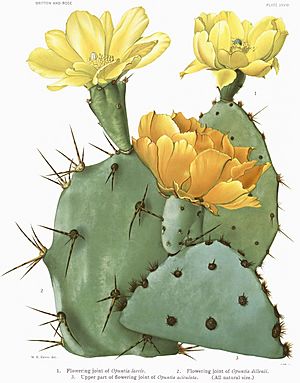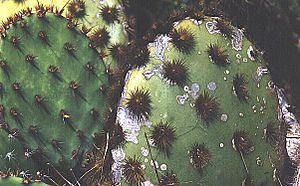Chenille pricklypear facts for kids
Quick facts for kids Chenille pricklypear |
|
|---|---|
 |
|
| Middle image is Opuntia aciculata | |
| Scientific classification |
Opuntia aciculata, also known as Chenille pricklypear, old man's whiskers, or cowboy's red whiskers, is a cool type of cactus. It's a perennial plant, meaning it lives for more than two years. This attractive cactus grows naturally in Texas in the United States. You can also find it in northern Mexico, especially in places like Nuevo León and Tamaulipas.
This cactus is part of the Opuntia family, which includes many types of prickly pear cacti. The name aciculata comes from a Latin word meaning "small pin." This refers to the tiny, needle-like spines on the cactus. One of its common names, Chenille pricklypear, describes the fuzzy, fringe-like spines around the edges of its pads.
Contents
What Does Opuntia Aciculata Look Like?
This cactus has many tiny, hair-like spines called glochids. They are usually golden yellow to dark red and are about 3 to 12 millimeters long. These glochids form thick clusters, especially along the edges of the cactus pads.
Sometimes, this cactus has no large spines at all. Other times, it might have one to three spines that can be up to 3 centimeters long. These larger spines are often yellowish or toasted brown at the bottom. They can also be folded and might fall off easily.
Flowers and Fruits
The Opuntia aciculata cactus produces beautiful, wide flowers. They can be golden yellow, orange, or even red. These flowers are quite large, about 8 to 10 centimeters across. While some people say the flowers are only yellow, many cultivated plants have bright red-orange flowers. Sometimes, the center of the flower can even be greenish.
The petals of the flowers are broad and rounded. The parts inside the flower (called filaments) are yellowish, and the stigma (the part that collects pollen) is a dull yellowish color with 8 to 10 green lobes. This cactus usually blooms in late spring or early summer.
After the flowers, the plant grows fruits. These fruits are typically shaped like pears and are covered with fine spines and glochids. They can be purple or green when ripe.
Where Does It Grow?
This cactus is native to the Chihuahuan Desert region. This desert stretches across parts of Texas in the southwestern United States and northern Mexico. It thrives in these hot, dry areas.
How Does It Survive?
Like other cacti, Opuntia aciculata is a succulent plant. This means it can store water in its thick pads. Its leaves have changed into spines. This helps the plant save water because spines don't lose as much water as regular leaves do. This special feature helps the cactus survive in the hot desert climate of Texas and northern Mexico.
The spines also act like a defense. They help protect the cactus from animals that might want to eat it.
This cactus is quite tough! It can grow new plants from pieces of its stem or even from cuttings of its pads. You just need to let the cut surface dry out a bit before planting it. For the best growth and lots of flowers, this cactus needs to be in full sunlight. It can also handle cold temperatures, down to about -5 to -12 degrees Celsius.
What Is It Used For?
The fruits of the Opuntia aciculata cactus are edible, meaning you can eat them! The soft pads, called nopales, can also be cooked and eaten like vegetables.
In some places, after the spines are burned off, the pads can be used as food for cattle. This provides a good source of nutrition for livestock.
See also
 In Spanish: Opuntia aciculata para niños
In Spanish: Opuntia aciculata para niños


